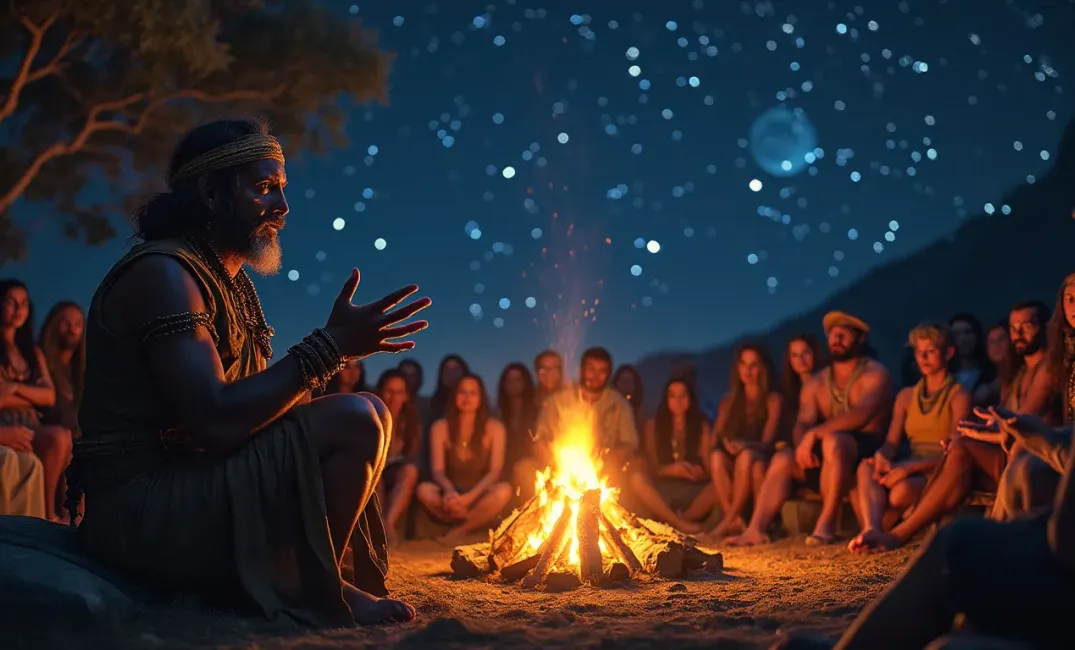Introduction: Weaving Tales of Humanity
Storytelling is an ancient craft, woven into the fabric of human existence. As much a part of human nature as the very air we breathe, storytelling serves not only as entertainment but as a conduit for communication, understanding, and cultural exchange. Stories capture the essence of humanity—our joys, fears, quests, and questions—imbuing them with meaning across generations. Whether spoken around fire-lit circles, written on parchment, or digitally shared across pixels, storytelling is a fundamental thread that binds the human tapestry. In this entry, we explore storytelling's evolution, its role in shaping societies, and its enduring legacy throughout history and beyond.
"A story is a way to say something that can't be said any other way..." — Flannery O'Connor
Origins of Storytelling: Born from Myths and Legends
From Oral Traditions to Written Records
- Primal Storytellers: The origins of storytelling reside in the oral traditions of early humans. Before written language, stories were shared verbally, combining gesture, rhythm, and narrative to convey history, morality, and cultural identity. These oral narratives were dynamic, changing with each teller but preserving core insights and values.
- Myths and Symbolism: Myths emerged as quintessential expressions of storytelling, exploring profound truths about existence and the cosmos. Figures like the Greek titan Prometheus or the trickster god Loki encapsulate universal archetypes, serving as allegories for human condition and the boundaries we seek to transcend.
The Dawn of the Written Word
- Ancient Scripts: With the development of writing, storytelling took on new dimensions. The Epic of Gilgamesh and Homer's epics exemplify early epic storytelling, capturing complex characters and vast narratives, allowing stories to transcend the bounds of place and time through texts on clay tablets and papyri.
- Symbols and Silhouettes: Script and imagery collaborated to tell stories—ancient Egyptians wove tales using hieroglyphs, while the indigenous cultures of the Americas etched their legends in colorful murals. These symbols offered not just stories but a mode of perceiving and interpreting the world.
Storytelling's Role in Societal Evolution
Cultivating Culture and Morals
- Foundations of Morality: Storytelling plays a pivotal role in shaping cultural norms and ethical paradigms. Parables, fables, and religious texts have long served as moral compasses, guiding communal behaviors and illustrating consequences through relatable characters and scenarios.
- Cultural Cohesion: Communities forge shared identities through collective storytelling. Folktales and indigenous legends celebrate unique narratives, nurturing a sense of place and belonging. In this way, storytelling aligns individual narratives within the broader cultural framework.
Shaping Collective Memory
- Historical Narratives: Historiography reflects storytelling's impact on how societies frame and interpret the past. Chronicles, sagas, and biographies capture the complexity of historical events and figures, transforming raw data into a coherent narrative often ripe with collective emotion and perspective.
- Reconstructing Identity: In times of upheaval, storytelling reconstructs and reaffirms identity. Memories of exodus and diaspora are preserved and transformed through narrative, offering resilience and continuity in the face of cultural or physical displacement.
Storytelling across Media: Adapting and Evolving
The Written Tale and Literary Canon
- The Novel's Rise: The proliferation of print technology in the Renaissance and beyond elevated the written story as cornerstone of narrative exploration. Novels, such as Austen's social satires or Dickens's social critiques, expanded storytelling through character depth and narrative complexity.
- Poetry and Expression: Poetic storytelling dives into the language of emotion, employing rhythm and metaphor to evoke visceral responses. Figures like Rumi and Emily Dickinson encapsulate human truths, echoing numinous understanding through verse.
The Age of Visual Storytelling
- The Cinematic Experience: Film revolutionized storytelling by combining visual art with narrative structure, offering empathic immersion in ways written or oral storytelling could not. Iconic films like Citizen Kane or The Matrix explore not only stories but the sensory experience of narrative.
- Television and Serialized Narratives: Television brought serialized storytelling into homes, weaving connections between episodes and fostering devoted communities. Shows become cultural touchstones, inviting discourse and communal experience while blurring boundaries between reality and fiction.
Digital and Interactive Storytelling
- The Digital Narrative: Digital platforms offer unparalleled freedom for storytellers, blending text, image, and sound within an interactive medium. Online stories and social media facilitate participatory narratives, challenging traditional roles of author and audience as stories evolve collectively.
- Immersive Realities: Virtual and augmented realities allow users to not only experience but shape storytelling environments, offering new means of engagement and exploration. Interactive mediums like video games create nonlinear narratives, empowering players with agency over story progression.
The Future of Storytelling: Charting New Shores
Crossing Dimensional Frontiers
- Cognitive and AI Narratives: Advances in artificial intelligence have begun transforming storytelling processes, generating narratives with neural networks and exploring new realms of creativity. While expanding possibilities, these technologies also probe delicate questions around authenticity, authorship, and emotional depth.
- Cosmic Chronicles: As humanity journeys beyond Earth, storytelling will play a pivotal role in shaping interstellar culture. The aesthetics and narratives crafted in space settlements might integrate cosmic frontiers with Earth's timeless tales, shaping multidimensional sagas that transcend terrestrial limitations.
Preserving Human Connection
- Narrative as Bridge: In an increasingly fragmented world, storytelling serves as a binding force. By humanizing diverse perspectives, narratives dissolve divides, nurturing empathy and unearthing commonalities amid the human struggle and triumph.
- Evolving Ethics of Storytelling: As storytellers wield immense influence, mindful curation of stories emerges as a crucial responsibility. Accurate representation, inclusivity, and ethical considerations must guide the evolving storytelling landscapes, ensuring stories honor the diversity and dignity of humanity.
Conclusion: Threads Woven Through Time
Storytelling endures as humanity's immortal thread, weaving meaning and connectivity through the ages. As technology evolves and frontiers expand, the essence of storytelling—a beacon of exploration and understanding—remains steadfast, guiding humanity toward a cohesive and inspired existence.
Beyond mere narrative, storytelling is a profound catalyst for connection and transformation, uniting divergent voices in the collective struggle for understanding. It reflects humanity's continuum of thought and defiance against fear, illuminating pathways of meaning through shadow and light across epochs.
"The world is shaped by two things — stories told and the memories they leave behind." — Vera Nazarian
Thus, in each story woven into the human fabric, we find whispers of our shared past, glimpses of unseen futures, and an indelible sense of being part of something timeless and greater than ourselves.
HUMANITY, CONNECTION, STORYTELLING, CULTURE, HISTORY, EVOLUTION, TECHNOLOGY, MORALITY, MEDIA, LEGACY

